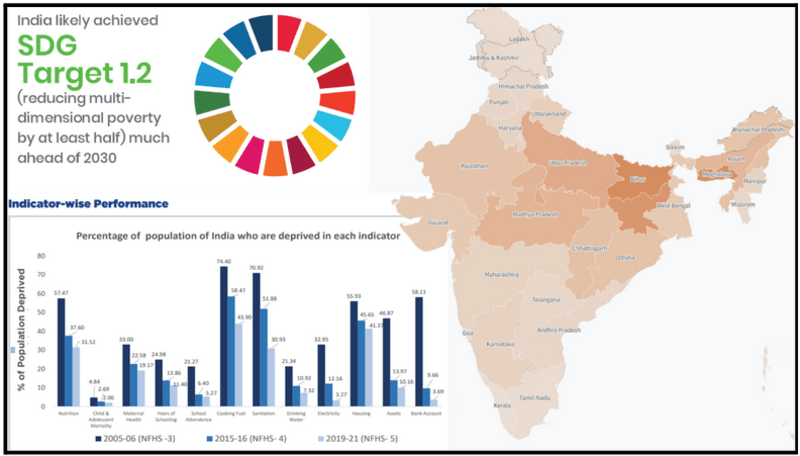Poverty studies need a nuanced approach
Relevance: GS I and III (Economy)
- Prelims: Multidimensional Poverty Report; NITI Aayog findings
- Mains: Post Pandemic and Poverty Issues; Development; NITI Aayog findings;
Why in the News?
The recent NITI Aayog reports paint a promising picture of progress, but a closer examination reveals complexities that warrant a nuanced assessment/approach.

About Multidimensional Poverty Index (MPI) and recent findings by NITI Aayog:
- MPI is a tool designed to gauge poverty beyond the constraints of income alone.
- By considering factors such as health, living standards, and other non-monetary dimensions, the MPI provides a more comprehensive understanding of poverty’s multifaceted nature.
- The methodology employed in this report follows the globally recognized Alkire Foster method, emphasizing the need to look beyond monetary measures when evaluating societal well-being.
|
What is the Alkire Foster (AF) method? The AF method starts with people. By mapping outcomes for each individual or household against the criteria being measured, the method captures both the percentage of people who are multidimensional poor and the overlapping deprivations that each individual or household faces. |
- The MPI serves as a commendable step towards redefining our understanding of poverty.
- By acknowledging that poverty extends beyond mere economic indicators, the MPI allows us to delve into the intricacies of human well-being.
- This approach is particularly relevant in the context of a country as diverse as India, where disparities in health, education, and living standards can be as significant as economic inequalities.

What are the set of limitations?
As India celebrates the achievements reflected in the NITI Aayog report, it must also recognize that the MPI, while a robust tool, has its own set of limitations.
- Reliance on Pre-pandemic data: It relies on available data and projections, often unable to capture the real-time dynamics of societal shifts, especially in the wake of unforeseen global disruptions like the Covid-19 pandemic.
- The backdrop against which these achievements are measured is crucial. The report relies on pre-pandemic data from the National Family Health Survey (NFHS) until 2019-21, projecting trends into 2022 and 2023.
- Issues for Long-term approach: This approach, while providing insights into long-term trends, may not fully capture the significant disruptions caused by the Covid-19 crisis.
How to build a Nuanced Approach?
- Working towards Social Fabric: In our pursuit of positive progress, we must not lose sight of the lessons the pandemic has imparted. The health emergency exposed vulnerabilities in our social fabric, and the repercussions were felt across sectors.
- It is imperative to learn from these experiences, fortifying our commitment to inclusive policies that can weather unforeseen storms.
- Safeguarding Individual: The multidimensional approach to poverty reduction should inspire a renewed dedication to building a society where the well-being of every individual is safeguarded against the challenges of an unpredictable world.
- The pandemic’s ramifications on education, health outcomes, and the implementation of government programmes tied to the MPI indicators cannot be ignored.
- As the world grappled with the health emergency, child mortality rates rose, and nutrition levels witnessed a decline.
- Need to change methodology for different regions:
- Moreover, the aftermath of the Covid-19 crisis saw governments globally tightening their fiscal belts, and India was no exception.
- The report’s positive findings in states like Uttar Pradesh, Bihar, and Madhya Pradesh – regions among the worst hit by the pandemic and funding cuts – raise questions about the sustainability and inclusivity of these gains.
- The NITI Aayog projections, based on sound methodology, may inadvertently overlook these medium-term setbacks, assuming that the pre-Covid progress continued seamlessly during and after the pandemic.
- Need for comprehensive and dynamic approach: The intricacies of the multifaceted nature of poverty demand a comprehensive and dynamic approach that adapts to the ever-changing landscape of global challenges.
- The report, while providing a snapshot of progress, should serve as a catalyst for more in-depth analysis and reflection.
- As we celebrate the millions lifted out of multidimensional poverty, we must also remain vigilant about the potential pitfalls that may compromise the sustainability of these gains.
- Need for adaptive policy framework: The post-Covid era demands a renewed commitment to social welfare, an adaptive policy framework, and an unwavering focus on the most vulnerable segments of society.
- Moving forward, policymakers must consider the broader context of economic and health crises when formulating strategies for poverty reduction.
- A holistic and inclusive approach that prioritizes resilient healthcare systems, robust social safety nets, and targeted interventions for the most vulnerable is paramount.
Conclusion:
The NITI Aayog report signals progress in the fight against multidimensional poverty in India. However, it also calls for a discerning eye that acknowledges the shadows cast by the pandemic and the ensuing fiscal constraints. By embracing a nuanced perspective, we can better understand the complexities of poverty reduction and work collectively towards building a more equitable and resilient society.
Prelims PYQs
Q. The Multi-dimensional Poverty Index developed by Oxford Poverty and Human Development Initiative with UNDP support covers which of the following?
- Deprivation of education, health, assets and services at household level
- Purchasing power parity at national level
- Extent of budget deficit and GDP growth rate at national level
Which of the statements given above is/are correct?
(a). 1 only
(b). 2 and 3 only
(c). 1 and 3 only
(d). 1, 2 and 3
Mains PYQs:
Q. Hunger and Poverty are the biggest challenges for good governance in India still today. Evaluate how far successive governments have progressed in dealing with these humongous problems. Suggest measures for improvement. (UPSC CSE 2017)
Q. “The incidence and intensity of poverty are more important in determining poverty based on income alone”. In this context analyze the latest United Nations Multidimensional Poverty Index Report. (UPSC CSE 2020)


